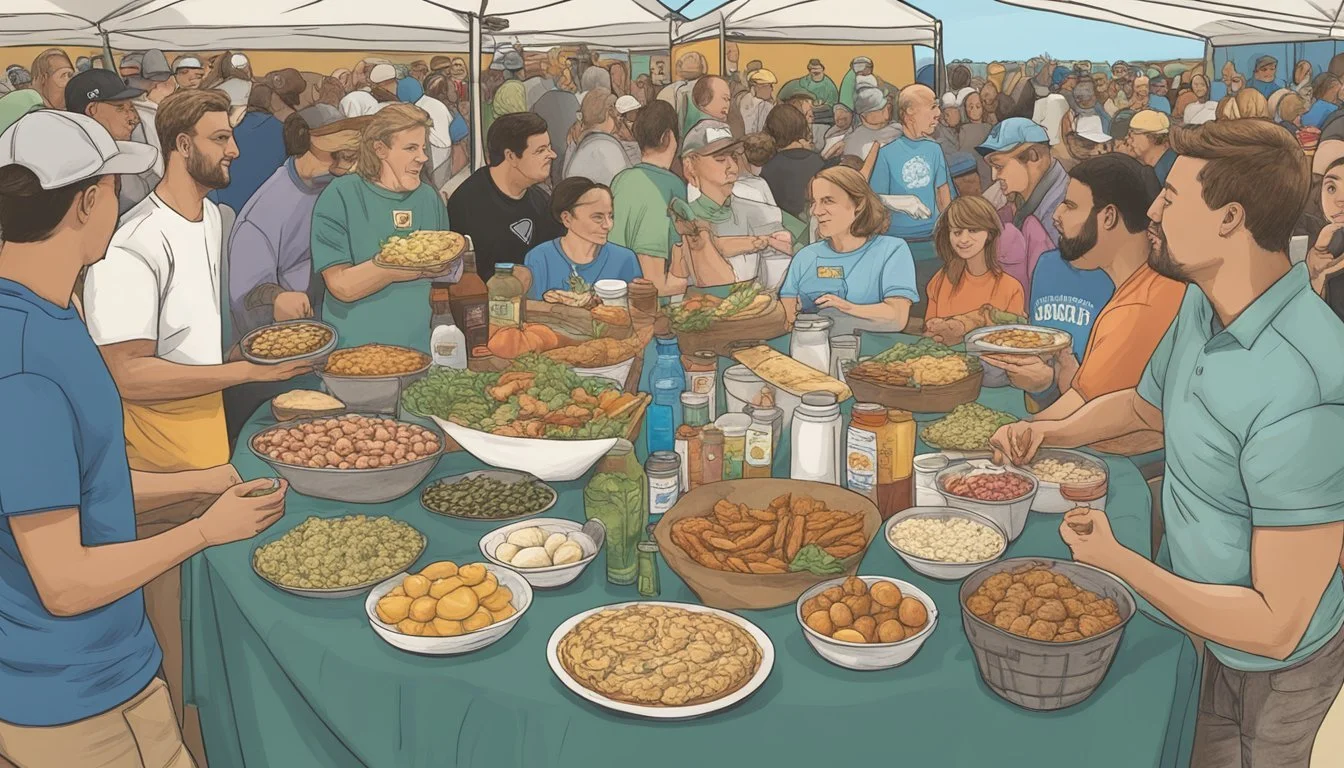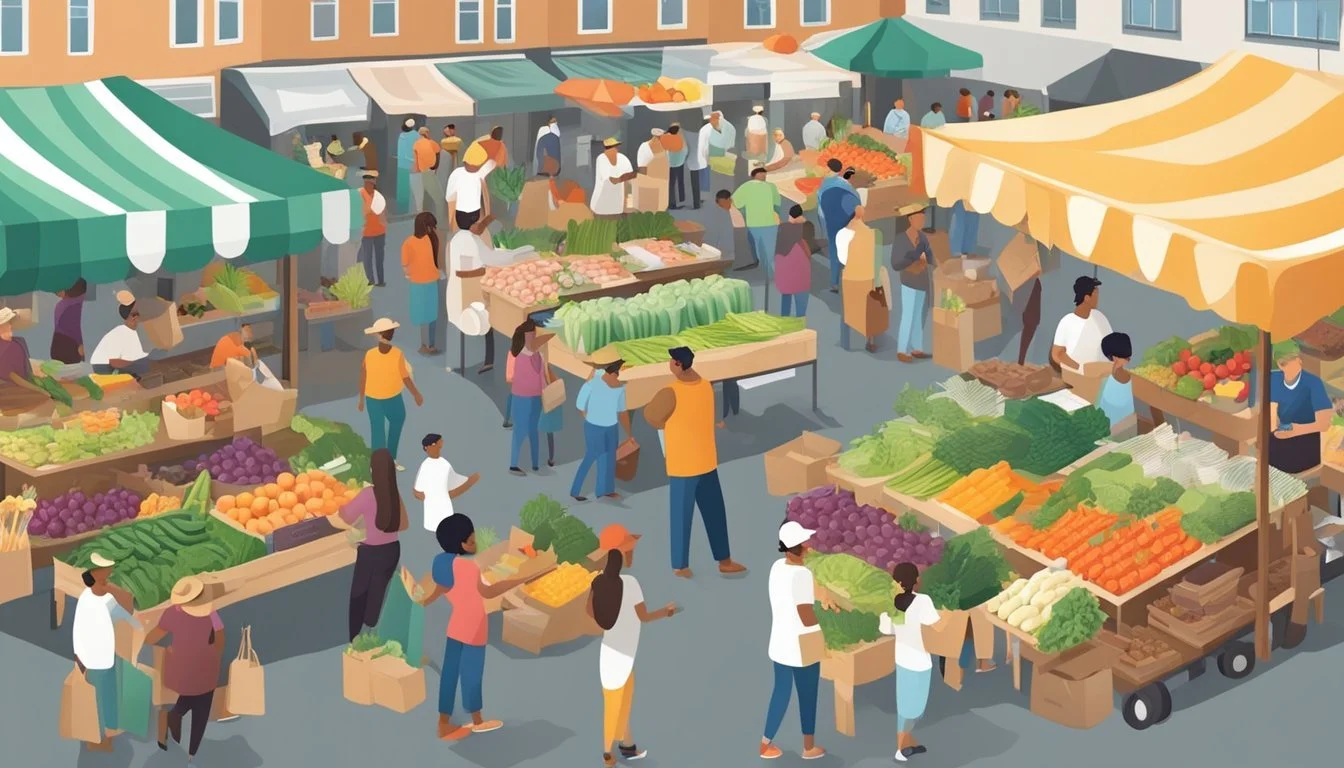North Carolina Food Challenges
A Tour of Epic Proportions
North Carolina is renowned for its diverse and hearty food scene, often celebrated through the array of food challenges scattered throughout the state. These challenges attract the brave and the hungry, offering them a chance to test their limits against some of the most generous, and sometimes daunting, meals that local eateries have to offer. From towering burger stacks and buckets of wings to belly-busting breakfasts, each challenge comes with its own set of rules, rewards, and regional flavor.
Completing these culinary trials often earns the victor more than just bragging rights. Many establishments reward the successful with the meal on the house, a spot on the wall of fame, or other exclusive prizes. Those willing to take on these feats will find themselves immersed in the local food culture, engaging with North Carolina's rich culinary traditions in a uniquely interactive, albeit stomach-stretching, way.
History of Food Challenges in North Carolina
The Tar Heel state has a storied history with food challenges that celebrate local cuisine and test the mettle of participants. In the early days of North Carolina, food challenges weren't formalized competitions but rather the daily trials faced by settlers, such as those documented during Christmas 1760 in the Moravian settlement at Bethania, where the consumption of a ginger cake was a novelty, not yet a challenge.
As North Carolina's culinary landscape evolved, so did the nature of its food challenges. Modern examples like the annual Krispy Kreme Challenge in Raleigh pay homage to the state's food production heritage. Here, participants run five miles and eat a dozen doughnuts at the halfway point.
These food challenges often reflect state pride—showcasing signature dishes or local ingredients. They weave together community, entertainment, and gastronomy:
Year
2004
Challenge
Krispy Kreme Challenge
Feat
Eat a dozen doughnuts and run five miles
Furthermore, North Carolina food challenges address, and sometimes highlight, larger issues within the food community, such as sustainability and food security. As the local food movement has grown, food challenges have subtly shifted to not only provide entertainment but also to draw attention to the quality and diversity of North Carolina's food systems. These events serve as an emblem of regional identity, where the fusion of tradition and competition fosters a sense of unity and resilience among North Carolinians.
Popular Food Challenges Across the State
North Carolina is home to a variety of food challenges that test the might and appetite of participants. From towering burger stacks to bowls of piping-hot pho, these challenges are scattered across the state, offering not just a meal but an adventure.
Burger Battles
In the realm of burger challenges, daring participants face off with colossal creations. One notable event is the Hwy 55 Five Five Challenge, which throws down the gauntlet with four beefy patties totaling 55 ounces of meat, plus fries and a 24-ounce drink. Conquer it within 30 minutes, and the meal is free.
Pizza Pile-Ups
Pizza challenges in North Carolina push the limits of crust, cheese, and toppings. Competitors attempt to devour oversized pies within a set time frame, earning them a spot on the wall of fame and, occasionally, the meal on the house.
Ice Cream Endurance Challenges
The ice cream challenge is not for the faint of heart or those prone to brain freeze. Contestants race against the clock to finish massive bowls of ice cream, a sweet trial of both speed and stamina.
BBQ Brawls
Barbeque challenges, or BBQ brawls, are a testament to North Carolina's love for smoked and flavorful meats. These challenges pit patrons against mounds of BBQ, from ribs to pulled pork, demanding both a strong will and a hearty appetite.
Pho Feasts
Finally, the Pho Feasts highlights the beloved Vietnamese noodle soup. At places like I Love Pho in Wilson, the challenge entails finishing a heaping bowl of pho overflowing with broth, noodles, and meats within a certain time, a delectable test of one's slurping capabilities.
Health Implications of Food Challenges
Food challenges, particularly access to nutritious food, significantly influence health outcomes. The absence of reliable sources of safe, nutrient-rich foods can lead to a cascade of health issues, including a higher incidence of chronic conditions.
In North Carolina, there's an observable association between food insecurity and high blood pressure, a risk factor for heart disease and stroke. Food-insecure individuals often rely on cheaper, processed foods high in sodium, which are linked to hypertension.
Obesity is another consequence tied to food challenges. Without access to fresh produce and lean proteins, caloric intake may increase with foods that are high in fat and sugar content. This can contribute to weight gain and the subsequent health challenges it presents.
The reliance on less nutritious food options can further compound health disparities in the state. Affected populations can experience deficiencies in critical nutrients, adversely impacting both physical and mental health.
Key Nutrient
Vitamin A
Iron
Calcium
Function
Vision and immune health
Oxygen transport in blood
Bone strength
Common Deficiency Impact
Increased infection risk
Anemia, Fatigue
Osteoporosis
Food challenges like those found in North Carolina are not just about hunger — they represent a critical intersection of nutrition and public health that demand comprehensive strategies to improve accessibility and education around healthy food choices. Efforts in this direction could alleviate the burden of diet-related diseases and foster a healthier, more resilient population.
Economic Impact of Food Challenges
The economy of North Carolina is significantly impacted by food challenges, including food insecurity and its cascading effects. Food challenges strain household budgets, limiting purchasing power and reducing consumer spending, which in turn affects retail businesses.
Retail Impact: When households are food insecure, they prioritize essential food purchases, often at the cost of variety and nutrition. This leads to a change in buying patterns, with consumers preferring low-cost energy-dense foods over healthier options. Retailers may experience a shift in demand, potentially resulting in reduced revenues and an altered market landscape.
Restaurant Industry: Food challenges can lead to decreased dining out, impacting restaurants. As families face budget constraints, spending on restaurant meals becomes infrequent, which reduces restaurant sales and can lead to job losses in the sector.
Jobs and Wages: The Food challenge effects on employment can ripple through the economy. Food-based businesses may need to reduce staff or wages to cope with decreased demand, which further perpetuates the cycle of economic hardship for those affected.
Social Services: Increased need for social services emerges as more individuals rely on food assistance programs. While these services provide crucial support, they also represent a cost to taxpayers and the state.
Agricultural Sector: Local farmers and producers can be impacted by food challenges. If consumer spending shifts or decreases, suppliers to retail and restaurants may face reduced orders, impacting their economic stability.
By addressing food challenges, North Carolina could potentially improve its economic situation, support local businesses, and enhance the overall well-being of its residents.
Food Challenges and Social Issues
North Carolina faces significant food challenges that intersect with social issues such as poverty, hunger, and disparities in food access across different communities. This section explores how food insecurity affects the state's residents, with particular attention to rural communities, children, and the overall health of households.
Addressing Food Insecurity
Food insecurity is a prevalent concern in North Carolina, with more than 1.2 million individuals affected by limited access to nutritious food. Efforts to combat this issue involve understanding the connection between food scarcity and poverty. Initiatives have been put in place to aid households in obtaining the healthy and good food required for sustenance.
Effects on Rural Communities
In rural areas of North Carolina, the scarcity of fresh, nutritious food options disproportionately affects residents. Rural communities often face obstacles such as fewer grocery stores and longer distances to travel for shopping, which contribute to higher levels of food insecurity. According to reports, households with children in these areas experience heightened challenges in obtaining adequate nutrition.
The Role of Food Challenges in Child Nutrition
Children in North Carolina are particularly vulnerable to the impacts of food challenges. Approximately 60 percent of public school students are considered food insecure, representing a significant portion of the youth affected by inadequate access to nutritious meals. The lack of healthy food options for these children can result in long-term negative effects on their growth, health, and academic performance.
Sustainable Food Practices in Challenges
Sustainable food practices in North Carolina face a variety of challenges, including the incorporation of local produce into wider markets and the complexities involved in strengthening farm-to-table connections. These obstacles require deliberate strategies to promote healthy eating and expand the availability of fresh fruits and vegetables.
Incorporating Local Produce
In North Carolina, farms and farmers markets strive to overcome distribution hurdles that limit the reach of local produce. They face the challenge of connecting with larger consumer bases to promote healthy eating. A strategy in place includes the development of partnerships between local food producers and philanthropic organizations, aiming to create more equitable and resilient food systems as noted in the North Carolina Food System Resiliency Strategy.
Highlighting Farm-to-Table Challenges
The difficulties in establishing and maintaining farm-to-table systems often center around logistics, such as how vegetables and fruits can travel from farms to consumers while still retaining freshness. Additionally, there is a continual effort to document the actions of food councils attempting to reimagine food systems as evidenced in reports like the 2022 Report on Policy and System Change Actions of the NC Food Network. These groups seek not only to bolster the farm-to-table movement but also to ensure economic viability for local food producers.
Navigating Food Challenges in North Carolina
The landscape of food security in North Carolina is complex, with particular emphasis on the importance of transportation and economic factors in ensuring access to adequate food. Citizens face a multitude of challenges, from disparities in access to the balancing act between price and portion size.
Transportation Access to Events
The availability and affordability of transportation can significantly impact one’s ability to attend food-related events, such as farmers markets, which often provide healthier food options. Rural areas, for instance, are particularly affected by transportation disparities, limiting residents' access to such events. A study highlights that nearly "1 in 3 children in rural North Carolina" are food insecure, implying a critical need for improved transit systems to food sources in these areas (The State of Food Insecurity in North Carolina During the Pandemic).
Recommended Strategies:
Establish mobile markets: Offering in-community shopping experiences that travel to different neighborhoods.
Build partnerships with transit authorities: To create routes that facilitate access to food distribution events.
Balancing Price and Portion Size
The food challenge in North Carolina extends beyond access, delving into the struggle between price and portion size. Economically, consumers are often caught between purchasing affordable food that lacks nutritional value and healthier options that are cost-prohibitive. The state's action plan suggests that over 1 million residents are unsure of their next meal, illuminating the urgency to address this balance (NCDHHS releases plan to tackle food insecurity).
Fast Facts:
17% of children in North Carolina are considered food insecure.
Price of food is a prohibitive factor for healthy eating for many families.
Proposed Solutions:
Subsidize healthier choices: Provide financial incentives for purchasing nutritious foods.
Educate consumers: On maximizing their food budget with healthy portion sizes without compromising nutrient intake.
Culinary Tourism and Food Challenges in North Carolina
North Carolina's rich food heritage and competitive spirit come together to offer a unique attraction: culinary tourism centered around food challenges. Tourists are regularly drawn to the state to indulge in local flavors and participate in these gastronomic contests.
Popular Food Challenges:
City Smoke's 14 Minute Challenge: A race against time in Charlotte to finish a hefty platter.
Krispy Kreme Challenge: Originating from Raleigh, a test of endurance combining running with doughnut eating.
Food enthusiasts can explore the local food challenges as they travel the state, providing a memorable and interactive way to experience the local cuisine.
Culinary Tours: Visitors often engage in curated tours led by food experts like retired UNC-Chapel Hill professor Marcie Cohen Ferris, where stories and foods are shared, further documented in her guidebook, which tourists can use as a reference. To experience North Carolina's food scene authentically, one can embark on the culinary pathways detailed in Edible North Carolina.
Impact on Local Economy: The combination of food tourism and challenges not only serves as an entertaining experience but also supports local businesses. Restaurants, food producers, and communities benefit from the influx of visitors looking for a taste of North Carolina and the thrill of a challenge.
Considerations for Participants: Food challenges can be intense. Participants should be mindful of their own health and dietary restrictions before diving into these competitive eating experiences.
Legal and Safety Regulations for Food Challenges
In North Carolina, food challenges must adhere to stringent health and safety regulations to ensure participant welfare. These contests often involve consuming large quantities of food in a short time, which can pose health risks.
Key Legal Frameworks:
The North Carolina Food Code Manual is vital for foodservice establishments hosting challenges. It highlights that all food used must meet safety standards and be prepared under hygienic conditions.
Food establishments are further bound by the general statutes on food protection provided by the NC Department of Health and Human Services.
Safety Considerations:
Food installations must assess potential choking hazards and ensure that staff are trained in first aid and emergency procedures, including the Heimlich maneuver.
Allergic reactions are a concern; thus, participants must be informed of all ingredients within the challenge items.
Venue Accountability:
Establishments must facilitate adequate supervision during challenges to promptly address health complications that may arise.
Patrons should be apprised of the risks associated with food challenges, including possible health outcomes as a result of overconsumption.
Documentation:
Venues are encouraged to keep the signed waivers on file acknowledging the voluntary participation and understanding of risks by contestants.
Post-Challenge Protocols:
After completion, establishments should monitor participants for signs of distress and have contact information for local emergency services readily available.
By ensuring compliance with these regulations and adopting proactive safety measures, food establishments can create a safe environment that allows for the enjoyment of food challenges while prioritizing participants' wellbeing.
Future of Food Challenges in North Carolina
Food challenges in North Carolina are poised to evolve due to economic trends, innovative policy responses, and increasing community engagement. As North Carolina grapples with the persisting challenge of food insecurity, which affects approximately 17% of children in the state, the outlook includes strategic collaborations and advancements in technology.
Innovation will likely play a critical role, with efforts to bolster the food system's resilience and equity. Initiatives may encompass the improvement of supply chain logistics, the introduction of sustainable farming practices, and the expansion of direct-to-consumer sales platforms.
Trends
Economic
Technological
Social
Potential Impact
Affecting the affordability and accessibility of food.
Enhancing food distribution and production efficiencies.
Driving demand for locally sourced and nutritious food.
The state's food councils and collaborative groups are expected to continue their focus on policy and system change actions, as documented by organizations assessing food systems changes. North Carolina's strategies may include strengthening the connection between local farms and consumers and implementing nutrition education programs.
Adaptation is also key in addressing future challenges. As climatic changes impact crop yields and food distribution, North Carolina will need agile response strategies to maintain food security. The state's commitment to this issue promises continued progress, with an eye on sustainable practices and equitable food access for all residents.
Supporting North Carolinian Food Culture
In North Carolina, food is more than sustenance; it's an expression of cultural heritage and community solidarity. The state's rich culinary traditions come from a diverse blend of influences, including Indigenous, African, and European cuisines.
Community and Collaboration
Communities often band together to preserve North Carolina's food culture amidst modern food challenges. Initiatives across the state, such as those by the Institute for Emerging Issues, focus on addressing food security while maintaining the integrity of local food traditions. These initiatives support farmers' markets and local food programs, aiming to keep the local food culture thriving.
Educational Programs
Educational institutions play a pivotal role by incorporating North Carolina's food heritage into their curricula. By teaching youth about the state's traditional foods and cooking methods, schools help perpetuate food culture knowledge.
Farmers' Perspectives
Keeping Traditions Alive: Farmers in the region work to grow crops that are central to the state's food identity, such as sweet potatoes and collard greens.
Innovative Farming: There's a push towards sustainable practices, as seen with the Center for Environmental Farming Systems, which aligns environmental stewardship with cultural preservation.
State Action Plans
The government's involvement is notable in that the NCDHHS State Action Plan for Nutrition Security not only aims to combat food insecurity but also to reinforce the fabric of North Carolinian food culture through nutrition security.
This multifaceted approach—embracing community efforts, education, sustainable farming, and governmental support—safeguards the rich tapestry of North Carolinian food culture while actively addressing current food challenges.












